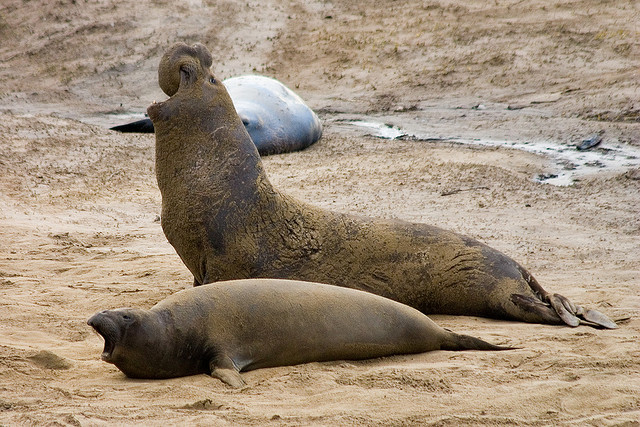Territorial Behavior in Pinnipeds
Biology 342 Fall 2015
Denis Ivanov, Stephanie Opiyo
Ontogeny
Central breeding areas
Male northern fur seals (Callorhinus ursinus) migrate towards central breeding areas (where a majority of females congregate during breeding season, henceforth referred to as CBAs) as they age. Males tend to begin claiming territories around the periphery of the central breeding areas at around age 7 (Kiyota, 2005). As they age, they establish territories that are closer or within the central breeding areas. In addition, they begin to return to the same territories within the CBA every breeding season.
Sexual size dimorphism
Sexual size dimorphism is prominent in land breeding marine mammals and contributes to the move towards the CBA as pinnipeds age. For males being larger is advantageous since defence of harems is necessary in order to maintain a territory near areas of high female populations, as these are more desirable areas and the competition to establish a territory in them is greater (Renouf, 1991). Since larger males tend to be the most dominant with higher success when intimidating smaller invasive males or in fights, it is less likely for the younger males to be able to claim a territory near CBA’s until their bodies have grown larger. Many vocal agonistic social signaling cues used in the defence of territories also serve as cues signaling age and readiness to reproduce in different male pinniped species, which also places younger males at a disadvantage with females being less likely to accept mounting by or mate with younger, weaker sounding males.

Large "bull" male elephant seal behind a smaller female. Note the extreme size dimorphism, males can grow to be much larger than this. Courtesy of Martin Taylor on Flickr.
Exceptions to the rule
There are some exceptions though, since occasionally dominant males will spontaneously abandon their territory within the CBA and a subordinate male will take up residence within any remainder of the territory that has not been appropriated by other dominant males. These subordinate males then have an opportunity to mate with the females within the abandoned territory until they are challenged again by larger more dominant males (Kiyota, 2005).
Other exceptions lie in water breeding pinnipeds. Sexual size dimorphism, has a tendency towards larger males in land breeding marine mammals because of the advantages that larger males have in reproduction and access to resources -- including territories closer to groups of females. In water breeding pinnipeds however, sexual size dimorphism is less pronounced and tends towards smaller, more agile males. Females do not tend congregate in large central groups, and agility is a more advantageous trait in order to be able to mate with a female, therefore unless other cues relating to sexual maturity or age are in used in deciding mates, younger, smaller males are at less of an advantage in these water breeding species in comparison to land breeding species.